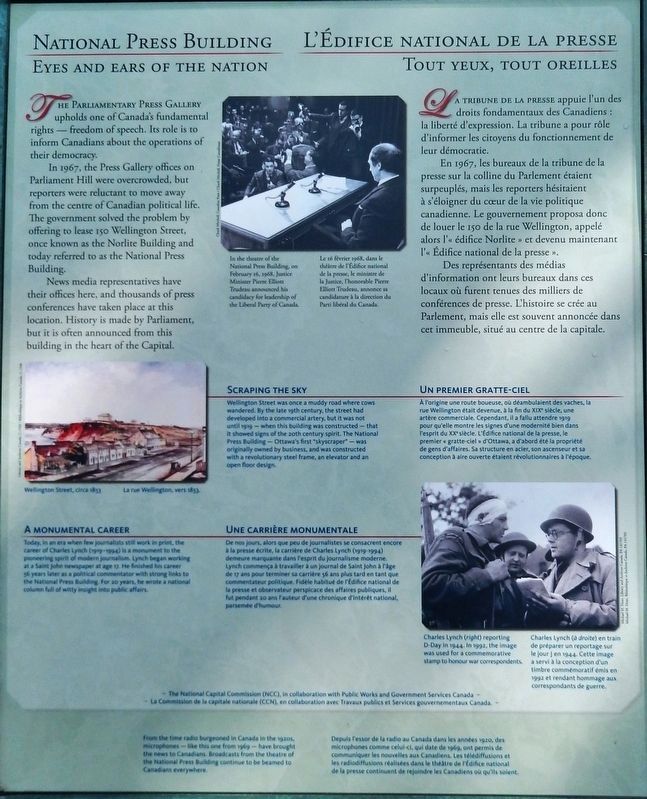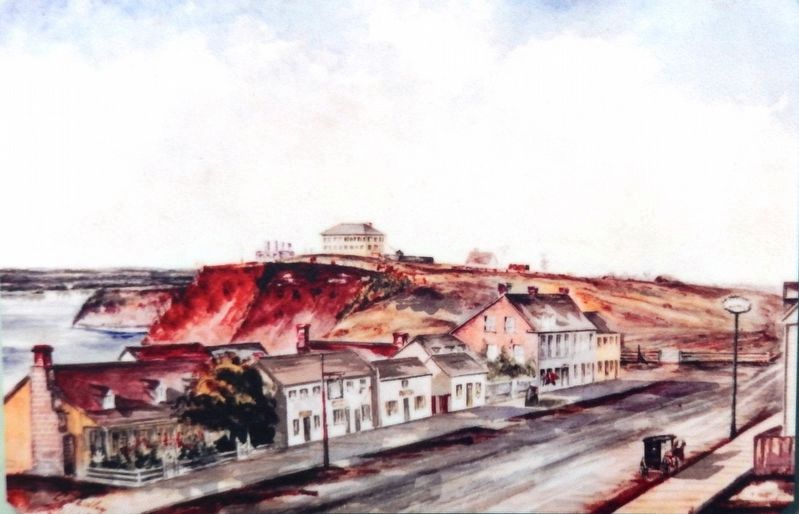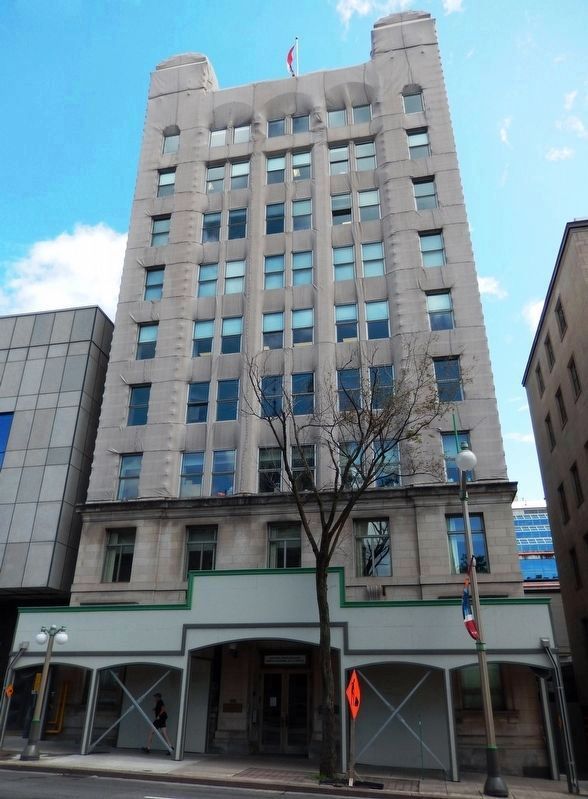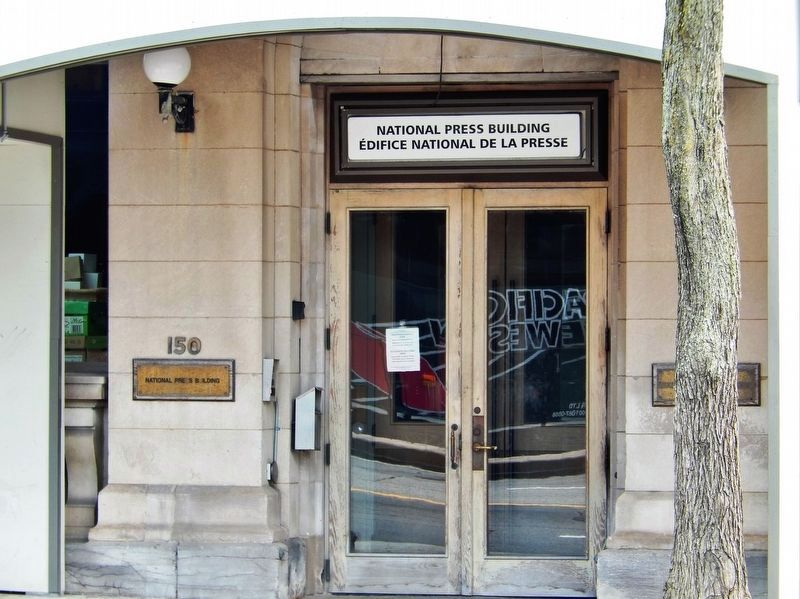Downtown Ottawa , Ontario — Central Canada (North America)
National Press Building / L’Édifice national de la presse
Eyes and Ears of the Nation / Tout yeux, tout oreilles
Inscription.
The Parliamentary Press Gallery upholds one of Canada's fundamental rights — freedom of speech. Its role is to inform Canadians about the operations of their democracy.
In 1967, the Press Gallery offices on Parliament Hill were overcrowded, but reporters were reluctant to move away from the centre of Canadian political life. The government solved the problem by offering to lease 150 Wellington Street, once known as the Norlite Building and today referred to as the National Press Building.
News media representatives have their offices here, and thousands of press conferences have taken place at this location. History is made by Parliament, but it is often announced from this building in the heart of the Capital.
Scraping the Sky
Wellington Street was once a muddy road where cows wandered. By the late 19th century, the street had developed into a commercial artery, but it was not until 1919 — when this building was constructed — that it showed signs of the 20th century spirit. The National Press Building — Ottawa's first "skyscraper" — was originally owned by business, and was constructed with a revolutionary steel frame, an elevator and an open floor design.
A Monumental Career
Today, in an era when few journalists still work in print, the career of Charles Lynch (1919-1994) is a monument to the pioneering spirit of modern journalism. Lynch began working at a Saint John newspaper at age 17. He finished his career 56 years later as a political commentator with strong links to the National Press Building. For 20 years, he wrote a national column full of witty insight into public affairs.
The National Capital Commission (NCC), in collaboration with Public Works and Government Services Canada
La tribune de la presse appuie l'un des droits fondamentaux des Canadiens : la liberté d'expression. La tribune a pour rôle d'informer les citoyens du fonctionnement de leur démocratie.
En 1967, les bureaux de la tribune de la presse sur la colline du Parlement étaient surpeuplés, mais les reporters hésitaient à s'éloigner du cœur de la vie politique canadienne. Le gouvernement proposa donc de louer le 150 de la rue Wellington, appelé alors l'« édifice Norlite » et devenu maintenant l'« Édifice national de la presse ».
Des représentants des médias d'information ont leurs bureaux dans ces locaux où furent tenues des milliers de conférences de presse. L'histoire se crée au Parlement, mais elle
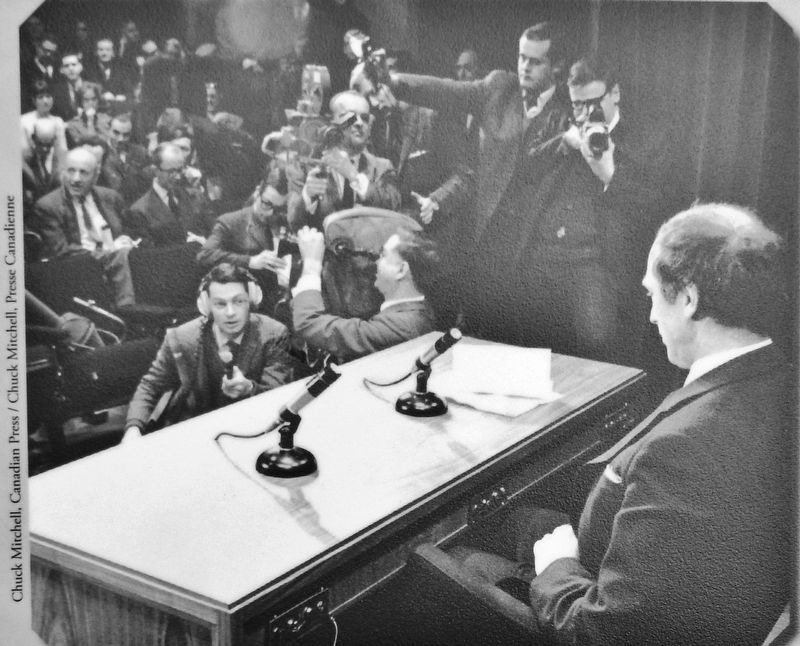
Photographed By Chuck Mitchell, Canadian Press
2. Marker detail: l'honorable Pierre Elliott Trudeau
• • •
Le 16 février 1968, dans le théâtre de l'Édifice national de la presse, le ministre de la Justice, l'honorable Pierre Elliott Trudeau, annonce sa candidature à la direction du Parti libéral du Canada.
Un premier gratte-ciel
À l'origine une route boueuse, où déambulaient des vaches, la rue Wellington était devenue, à la fin du XIXe siècle, une artère commerciale. Cependant, il a fallu attendre 1919 pour qu'elle montre les signes d'une modernité bien dans l'esprit du XXe siècle. L'Édifice national de la presse, le premier « gratte-ciel » d'Ottawa, a d'abord été la propriété de gens d'affaires. Sa structure en acier, son ascenseur et sa conception à aire ouverte étaient révolutionnaires à l'époque.
Une carrière monumentale
De nos jours, alors que peu de journalistes se consacrent encore à la presse écrite, la carrière de Charles Lynch (1919-1994) demeure marquante dans l'esprit du journalisme moderne. Lynch commença à travailler à un journal de Saint John à l'âge de 17 ans pour terminer sa carrière 56 ans plus tard en tant que commentateur politique. Fidèle habitué de l'Édifice national de la presse et observateur perspicace des affaires publiques, il fut pendant 20 ans l'auteur d'une chronique d'intérêt national, parsemée d'humour.
La Commission de la capitale nationale (CCN), en collaboration avec Travaux publics et Services gouvernementaux Canada
Erected by The National Capital Commission / La Commission de
la capitale nationale.
Topics. This historical marker is listed in this topic list: Communications. A significant historical year for this entry is 1967.
Location. 45° 25.348′ N, 75° 42.039′ W. Marker is in Ottawa, Ontario. It is in Downtown Ottawa. Marker is on Wellington Street (Route 34) west of O'Connor Street (Route 87), on the right when traveling west. Marker is located along the sidewalk directly across Wellington Street from the National Press Building. Touch for map. Marker is at or near this postal address: 150 Wellington Street, Ottawa ON K1A 0A6, Canada. Touch for directions.
Other nearby markers. At least 8 other markers are within walking distance of this marker. Asbury College (about 90 meters away, measured in a direct line); Thomas D'Arcy McGee (about 150 meters away); Railways and Radio Waves / Chemins de fer et ondes radio (about 180 meters away); 100 Wellington Street / 100, Rue Wellington (about 180 meters away); Parliament Clocktower Bell (about 210 meters away); Terry Fox 1958 -1981 (about 210 meters away); Henry Albert Harper (about 210 meters away); Canada’s Capital (about 240 meters away). Touch for a list and map of all markers in Ottawa.
Regarding National Press Building / L’Édifice national de la presse. The National Press Building is a Recognized Federal Heritage Building because of its historical associations, and its architectural and environmental

Michael M. Dean, Library and Archives Canada, PA-141705
4. Marker detail: D-Day 1944
• • •
Charles Lynch (à droite) en train de préparer un reportage sur le jour J en 1944. Cette image a servi à la conception d'un timbre commémoratif émis en 1992 et rendant hommage aux correspondants de guerre.
Related markers. Click here for a list of markers that are related to this marker. Confederation Boulevard / Boulevard de la Confédération
Also see . . .
1. National Press Building (Ottawa). Wikipedia entry:
Offices in the building are provided to journalists at cost by the federal government, with some other facilities remaining in the Centre Block. The building is home to a wide array of news agencies, both national and foreign, and all forms of media. The National Press Club is situated on the second floor. (Submitted on May 31, 2020, by Cosmos Mariner of Cape Canaveral, Florida.)
2. Charles Burchill Lynch. The Canadian Encyclopedia website entry:
At the end of 1943 he joined Reuters as a correspondent and went to London in 1944. He reported the troops storming ashore on D-Day (1944), and until war's end he covered the 1st Canadian and 2nd British armies. Later, he was a Reuters correspondent covering the war crimes trials in Nuremburg. He was chief of Southam News Services and for 2 decades wrote a 5-times-weekly column for the Southam chain. (Submitted on May 31, 2020, by Cosmos Mariner of Cape Canaveral, Florida.)

Photographed By Cosmos Mariner, August 10, 2019
5. Radio Microphone, 1969
(at bottom center of marker)
(at bottom center of marker)
• • •
Depuis l'essor de la radio au Canada dans les années 1920, des microphones comme celui-ci, qui date de 1969, ont permis de communiquer les nouvelles aux Canadiens. Les télédiffusions et les radiodiffusions réalisées dans le théâtre de l'Édifice national de la presse continuent de rejoindre les Canadiens où qu'ils soient.
Credits. This page was last revised on November 12, 2023. It was originally submitted on May 29, 2020, by Cosmos Mariner of Cape Canaveral, Florida. This page has been viewed 200 times since then and 22 times this year. Photos: 1, 2, 3, 4, 5, 6, 7, 8. submitted on May 31, 2020, by Cosmos Mariner of Cape Canaveral, Florida.
